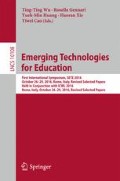Abstract
This study attempts to enhance students’ willingness to communicate in the field of English technical terms learning. The proposed learning design aims to train students in using various meaning negotiation strategies to discuss and clarify the meaning of given English technical terms and acquire the different aspects of word knowledge of these terms. Twenty-five senior students in a technology institute were provided with interesting corporative films introducing these English technical terms. At the end, participants completed a video-making project demonstrating the target English technical terms. The pre- and post-test of English technical terms and survey of willingness to communicate showed that the proposed learning not only improved students’ vocabulary, but also increased significantly their willingness to communicate in English. The results could provide a new way of English technical terms learning.
Access this chapter
Tax calculation will be finalised at checkout
Purchases are for personal use only
References
Kaewpet, C.: Communication needs of Thai civil engineering students. Engl. Specif. Purp. 28, 266–278 (2009)
Kassim, H., Ali, F.: English communicative events and skills needed at the workplace: feedback from the industry. Engl. Specif. Purp. 29, 168–182 (2010)
Kang, D.-M.: The effects of study-abroad experiences on EFL learners’ willingness to communicate, speaking abilities, and participation in classroom interaction. System 42, 319–332 (2014)
Cao, Y.-Q., Philp, J.: Interactional context and willingness to communicate: a comparison of behavior in whole class, group and dyadic interaction. System 34, 480–493 (2006)
MacIntyre, P.D., Baker, S., Clément, R., Conrad, S.: Willingness to communicate, social support, and language learning orientations of immersion students. Stud. Second Lang. Acquisition 23, 369–388 (2001)
Kang, S.-J.: Dynamic emergence of situational willingness to communicate in a second language. System 33, 277–292 (2005)
Cao, Y.: Investigating situational willingness to communicate within second language classrooms from an ecological perspective. System 39, 468–479 (2011)
MacIntyre, P.D.: Variables underlying willingness to communicate: a causal analysis. Commun. Res. Rep. 12, 241–247 (1994)
MacIntyre, P.D., Clément, R., Dörnyei, Z., Noels, K.A.: Conceptualizing willingness to communicate in a L2: a situational model of confidence and affiliation. Mod. Lang. J. 82, 545–562 (1998)
Baker, S., MacIntyre, P.: The role of gender and immersion in communication and second language orientations. Lang. Learn. 50, 311–341 (2000)
Rupley, W.H., Logan, J.W., Nichols, W.D.: Vocabulary instruction in a balanced reading program. Reading Teacher 52, 336–346 (1998)
Newton, J.: Task-based interaction and incidental vocabulary learning: A case study. Second Lang. Res. 11, 159–177 (1995)
Pritchard, R.M.O., Nasr, A.: Improving reading performance among Egyptian engineering students: principles and practice. Engl. Specif. Purp. 23, 425–445 (2004)
Rusanganwa, J.: Multimedia as a means to enhance teaching technical vocabulary to phys-cs undergraduates in Rwanda. Engl. Specif. Purp. 32, 36–44 (2013)
Pica, T., Doughty, C.: The role of group work in classroom second language acquisition. Stud. Second Lang. Acquisition 7, 233–248 (1985)
Shehadeh, A.: Task-based language learning and teaching: theories and applications. In: Edwards, C., Willis, J. (eds.) Teachers Exploring Tasks in English Language Teaching, pp. 13–30. Palgrave Macmillan, U.K. (2005)
Foster, P., Ohta, A.S.: Negotiation for meaning and peer assistance in second language classrooms. Appl. Linguist. 26, 402–430 (2005)
Nunan, D.: Task-Based Language Teaching. Cambridge University Press, Cambridge (2004)
Kearney, E.: A high leverage language teaching practice: Leading an open ended group discussion. Foreign Lang. Ann. 48(1), 100–123 (2015)
Yashima, T., Zenuk-Nishide, L.: The impact of learning contexts on proficiency, attitudes, and L2 communication: creating an imagined international community. System 36, 566–585 (2008)
Mayer, R.E.: Applying the science of learning: eidence-based principles for the design of multimedia instruction. Am. Psychol. 63, 760–769 (2008)
Willis, J.: A framework for task-based learning. Longman, London (1996)
Long, M.H.: Inside the ‘black box’: methodological issues in classroom research on language learning. Lang. Learn. 30, 1–42 (1980)
McCroskey, J.C., Richmond, V.P.: Willingness to communicate. In: McCroskey, J.C., Daly, J.A. (eds.) Personality and Interpersonal Communication, pp. 129–156. Sage, Beverly Hills, CA (1987)
Pica, T., Young, R., Doughty, C.: The impact of interaction on comprehension. Tesol Q. 21, 737–758 (1987)
Ellis, R., Tanaka, Y., Yamazaki, A.: Classroom interaction, comprehension, and the acquisition of L2 word meanings. Lang. Learn. 44, 449–491 (1994)
Aron, A., Aron, E.N., Coups, E.J.: Statistics for Psychology, 4th edn. Pearson Education, Upper Saddle River, N.J. (2006)
Author information
Authors and Affiliations
Corresponding author
Editor information
Editors and Affiliations
Rights and permissions
Copyright information
© 2017 Springer International Publishing AG
About this paper
Cite this paper
Tai, Y., Ting, YL., Hsieh, PS. (2017). Improving Students’ English Technical Terms Learning and Willingness to Communicate Through Meaning Negotiation. In: Wu, TT., Gennari, R., Huang, YM., Xie, H., Cao, Y. (eds) Emerging Technologies for Education. SETE 2016. Lecture Notes in Computer Science(), vol 10108. Springer, Cham. https://doi.org/10.1007/978-3-319-52836-6_21
Download citation
DOI: https://doi.org/10.1007/978-3-319-52836-6_21
Published:
Publisher Name: Springer, Cham
Print ISBN: 978-3-319-52835-9
Online ISBN: 978-3-319-52836-6
eBook Packages: Computer ScienceComputer Science (R0)

